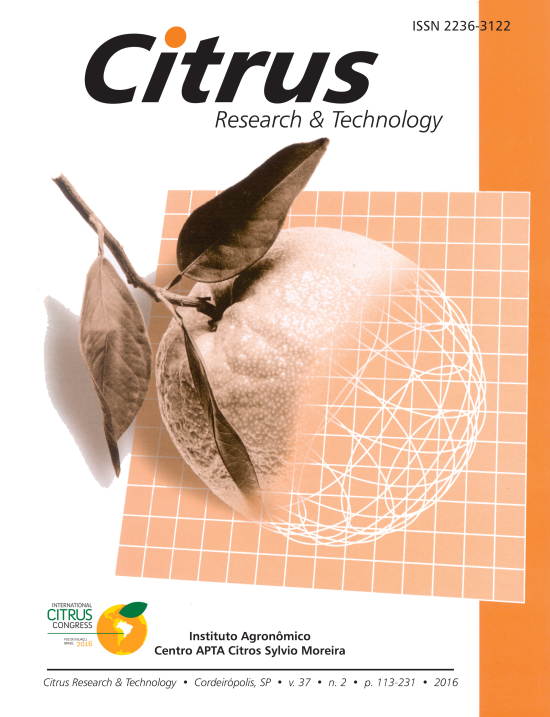Atributos de frutos e crescimento vegetativo de porta-enxertos de citrandarins em viveiro
Fruit traits and vegetative growth of citrandarins rootstocks in the Nursery
Evandro Henrique Schinor, André Luis Do Nascimento, Vera Lucia Nishijima Paes De Barros, Marinês Bastianel, Fernando Alves De Azevedo & Mariângela Cristofani-Yaly
Resumo
A ampliação do número de variedades para utilização como porta-enxerto em plantios comerciais de citros tem sido um dos principais objetivos dos programas de melhoramento genético. Objetivou-se avaliar atributos de frutos e crescimento vegetativo inicial, em viveiro, de dezenove citrandarins, híbridos de Citrus sunki vs Poncirus trifoliata cv. Rubidoux. Avaliaram-se as seguintes variáveis de frutos: altura, diâmetro, massa, número de gomos e número de sementes viáveis e inviáveis por fruto e, também, número de embriões por semente. A porcentagem de emergência das sementes foi determinada após semeadura em tubetes. Para se determinar o crescimento dos citrandarins em viveiro, as mudas foram transferidas para sacolas plásticas de 3,0 L contendo substrato comercial, medindo-se altura da planta e diâmetro do caule, no momento da transplantação e aos 60, 120 e 180 dias após. A massa seca da raiz e da parte aérea de cada genótipo foi quantificada aos 180 dias. Os citrandarins TSxPT 73 e 137 foram os genótipos que apresentaram maior número de sementes por fruto. Após 180 dias da transplantação, a massa seca da parte aérea e do sistema radicular foi superior para os citrandarins TSxPT 137 e 151, respectivamente. O citrandarin TSxPT 151 apresentou apenas 40% de emergência das sementes, sendo inferior aos demais, dificultando seu uso comercial. Dezoito citrandarins apresentaram boas taxas de emergência (>63%) e crescimento vegetativo inicial adequados para a produção de mudas, indicando seu potencial de uso como novos porta-enxertos.
Palavras-chave
Abstract
The increase in the number of varieties for use as rootstock in commercial citrus cultivation has been a major goal of breeding programs. This study aimed to evaluate fruit traits and the initial growth in the nursery of nineteen citrandarins, hybrids of Citrus sunki vs. Poncirus trifoliata cv. Rubidoux. The following fruit variables were evaluated: height, diameter, and weight, number per seed of segments and the number of viable and unviable seeds per fruit and the number of embryos. Rootstock emergence was determined after sowing in tubes. To determine the initial growth of the citrandarins, the seedlings were transferred to plastic bags of 3.0 L containing commercial substrate with plant height and stem diameter being measured at transplanting and after 60, 120 and 180 days. The dry mass of roots and shoots of each genotype was quantified at 180 days. The citrandarins TSxPT 73 and 137 were the genotypes that showed a higher number of seeds per fruit. The dry weight of shoot and root system was higher in citrandarins TSxPT 137 and 151, respectively, after 180 days of transplant. The citrandarin TSxPT 151 showed only 40% of emergency seeds, being smaller than the others, hindering its commercial use. Eighteen citrandarins showed good emergency rates (> 63%) and early vegetative growth suitable for the production of seedlings, indicating its potential use as new rootstocks.

